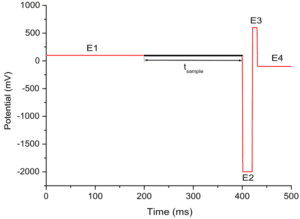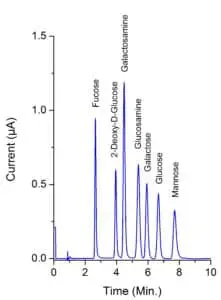Pulsed amperometric detection
What is pulsed amperometric detection?
Pulsed amperometric detection (PAD), is used in the HPLC analysis of carbohydrates and related substances. At a high pH carbohydrates can be oxidized and analyzed with high sensitivity. By using PAD the measurement conditions remain stable and reproducible.

How does pulsed amperometric detection work?
In pulsed amperometric detection (PAD), a rapid sequence of potential steps is applied. During a part of this ‘pulse sequence’, the signal is sampled. The other part of the sequence of steps, are oxidative and reductive cleaning steps. During this cleaning, the gold working electrode is regenerated. The process usually repeats about every half second. This ensures stable and reproducible detection conditions.
The use of PAD is really necessary, because EC detection (oxidation) of carbohydrates results in reaction products that stick to the electrode surface. This contaminates the electrode and causes a bad reproducibility. When using PAD with cleaning steps, the electrode remains clean and reproducible.
A side effect of the applied pulse mode is that the gold electrode is slowly consumed in the process. After long-term use (weeks, months) it can be seen that a little gold has disappeared. The Antec flow cells are using a solid gold electrode, in case needed the electrode surface can be restored by using our metal polishing kit. The traditional 3-step detection pulse has more wear than the newer 4-step pulse. A FlexCell with replaceable working electrode can be used for both. A SenCell is recommended for a 4-step pulse only.

Measurement potential E1 with cleaning pulse E2 – E4. Measurement is on the second half of E1 (t-sample), when the current is stabilized.
Why is carbon dioxide removal necessary in HPAEC?
High Performance Anion Exchange Chromatography (HPAEC) is used for HPLC analysis of carbohydrates. It is only at very high pH that carbohydrates are anions and can be separated. Therefore, only a few HPAEC columns can be used as they have to be used at pH 12 or higher.
At such high pH, carbon dioxide from the surrounding air dissolves in the mobile phase and forms carbonate ions. The slowly rising concentration of carbonate enters the column, it occupies functional groups of the stationary phase and changes the retention times of carbohydrates. It is therefore most important to have proper carbon dioxide removal from the mobile phase to ensure reproducible separation conditions.
The ALEXYS eluent tray has the infrastructure for keeping the solvent bottles under a nitrogen (or helium) blanket. Gas tight caps, tubing, fittings and a manometer to adjust the gas flow and to keep inert gas consumption to an absolute minimum.

HPAEC separation and pulsed amperometric detection of carbohydrates.